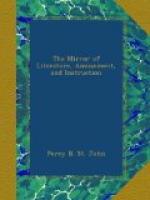The west side of the quadrangle, which is the most ancient, was originally built and inhabited by Edward I., and is also interesting as the birth-place of Queen Mary. The room in which she first saw the light is on the second story. Her father, James V., then dying of a broken heart at Falkland, on account of the disaster at Solway Frith, prophetically exclaimed, “It came with a lass,” alluding to his family having obtained the crown by marriage, “and it will go with a lass.”
The east side, begun by James III., and completed by James V., contains the Parliament Hall. This was formerly the front of the palace, and the porch was adorned with a statue of Pope Julius II., who presented James V. with a consecrated sword and helmet for his resistance to the Reformation. This statue escaped the iconoclastic zeal of the Reformers; but at the beginning of the last century was destroyed by a blacksmith, whose anger against the Papal power had been excited by a sermon.
On an inn-window at Tarbet, in Dunbartonshire, is perhaps the longest specimen of brittle rhymes ever written. They are signed “Thomas Russell, Oct. 3, 1771,” and extend to thirty-six lines, being a poetical description of the ascent to Ben Lomond. What would Dr. Watts have said to such a string of inn-window rhymes!
Ossian.
The principal curiosity in the environs of Dunkeld is the Cascade of the Bran at Ossian’s Hall, about a mile distant. This hermitage, or summer-house, is placed on the top of a perpendicular cliff, 40 feet above the bottom of the fall, and is so constructed, that the stranger, in approaching the cascade, is entirely ignorant of his vicinity to it. Upon entering the building is seen a painting, representing Ossian playing on his harp, and singing to a group of females; beside him is his hunting spear, bow and quiver, and his dog Bran. This picture suddenly disappears, and the whole cataract foams at once before you, reflected in several mirrors, and roaring with the noise of thunder. A spectacle more striking it is hardly possible to conceive. The stream is compressed within a small space, and at the bottom of the fall has hollowed out a deep abyss, in which its waters are driven round with great velocity. A little below the hall is a simple arch thrown across the chasm of the rocks, and hence there is a good view of the fall.
Half a mile further up the Bran is Ossian’s Cave, part of which has been artificially made; and about a mile higher is the Rumbling Bridge, thrown across a chasm of granite about 15 feet wide. The river for several hundred feet above the arch is crowded with massive fragments of rock, over which it foams and roars; and, approaching the bridge, precipitates itself with great fury through the chasm, making a fall of nearly 50 feet.
Returning to Ossian’s Hall, the tourist may continue his excursion along the face of Craig Vinean, the summit of which commands one of the finest prospects in this vicinity. Hence he may form some idea of the extent to which the Duke of Atholl has carried his system of planting. His Grace is said to have planted more than thirty millions of trees in the neighbourhood of Dunkeld.




